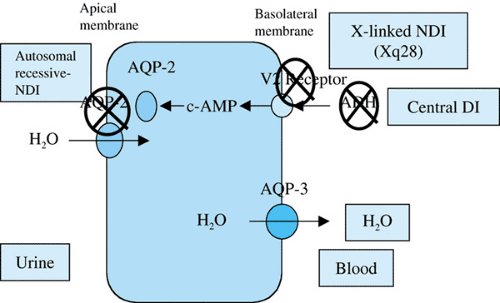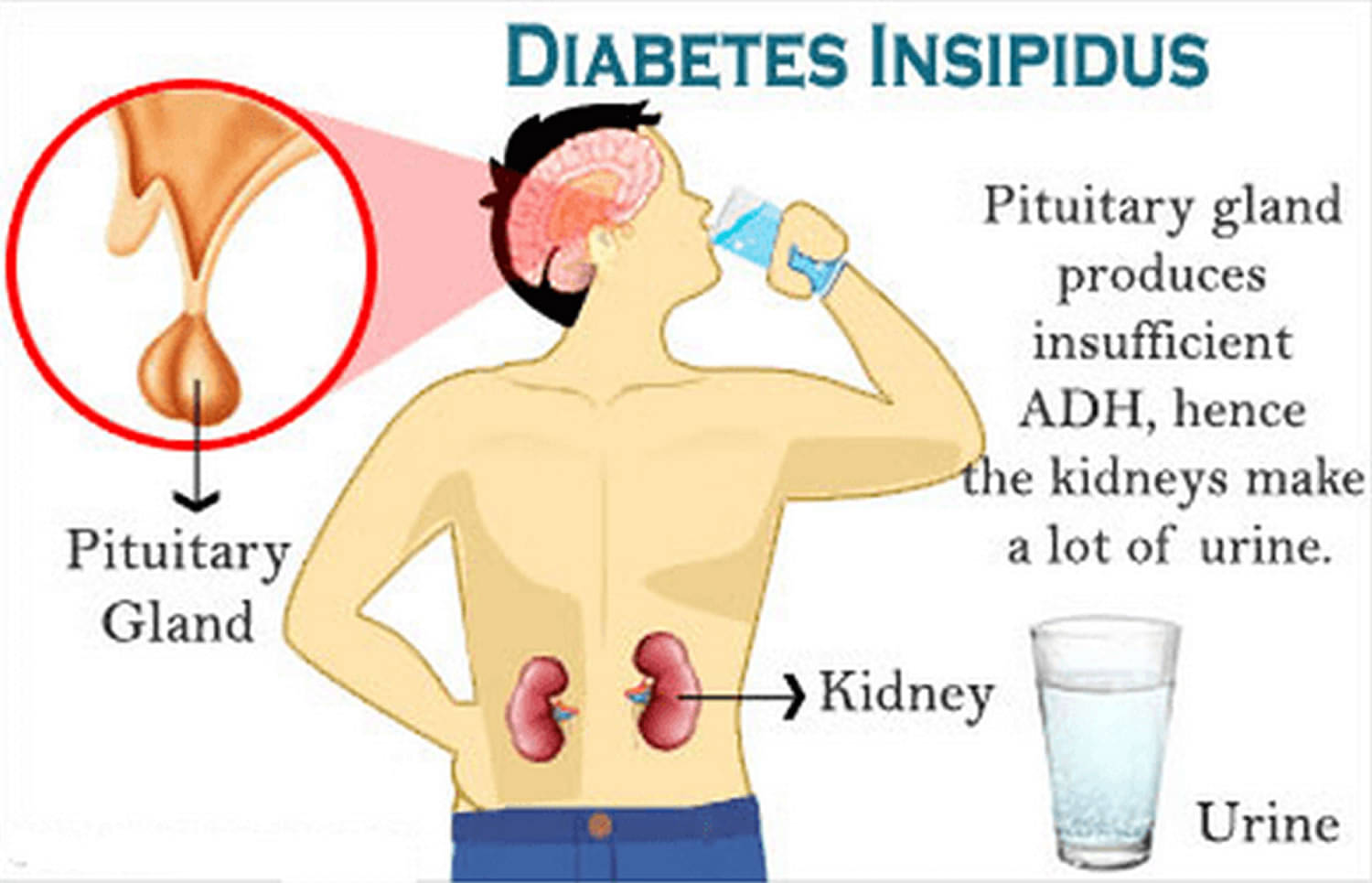Diabetes Insipidus Complications

Nephrogenic Diabetes Insipidus Treatments And More
Diabetes insipidus better health channel.

5 common diabetes insipidus complications diabetes insipidus is a rare condition in which the affected person feels excessive thirst and passes large amounts of urine frequently. even if the person drinks less amount of water, the urine formation remains unaffected. Diabetesinsipidus results in excessive drinking and urination. as many conditions cause these signs, a number of diagnostic tests including bloodwork and urinalysis need to be performed to rule out other causes. after more common causes are ruled out, a modified water deprivation test can confirm disease and an mri or therapeutic trial can be performed. Diabetes mellitus is described as a lack of insulin, the hormone used in sugar metabolism. diabetes insipidus is caused by the lack of vasopressin, the hormone that helps the kidneys absorb water, and is less common than diabetes mellitus. both categories of diabetes can cause serious complications in dogs and should be treated. Diabetes insipidus and diabetes mellitus—which includes both type 1 and type 2 diabetes—are unrelated, although both conditions cause frequent urination and constant thirst. diabetes mellitus causes high blood glucose, or blood sugar, resulting from the body's inability to use diabetes insipidus complications blood glucose for energy.
Diabetes Insipidus Niddk
Diabetes insipidus can result in dangerous dehydration if a person does not increase their water intake, such as when a patient cannot communicate their thirst or help themselves. The 2 main complications of diabetes insipidus are dehydration and an electrolyte imbalance. complications are more likely if the condition goes undiagnosed or is poorly controlled. dehydration. if you have diabetes insipidus, your body will find it difficult to retain enough water, even if you drink fluid constantly. The complications of diabetes insipidus can be wide and varied, just as the presentation of the disease itself can be quite unique. use this guide to determine what complications may be faced in the future, work with an endocrinologist to develop an effective treatment plan, and make sure there are enough fluids close by at any given time. The main complication of diabetes insipidus is dehydration if fluid loss is greater than liquid intake. a health care provider can diagnose a person with diabetes insipidus based on a medical and family history, a physical exam, urinalysis, blood tests, a fluid deprivation test, and magnetic resonance imaging (mri).
Diabetes insipidus (di) is a condition characterized by large amounts of dilute urine and increased thirst. the amount of urine produced can be nearly 20 liters per day. reduction of fluid has little effect on the concentration of the urine. complications may include dehydration or seizures. Diabetes insipidus is a different disease from diabetes mellitus. their names are similar, but the only things they have in common is that they make you thirsty and make you pee a lot. Nephrogenic diabetes insipidus is a long name for an uncommon condition. nephrogenic diabetes insipidus diabetes insipidus complications is not the same as diabetes mellitus. diabetes mellitus causes elevated blood sugar levels.
diet diabetes education diabetes food diabetes information diabetes insipidus diabetes cookie diabetic cooking diabetic dessert recipe diabetic Central diabetes insipidus. damage to the pituitary gland or hypothalamus from surgery, a tumor, a head injury or an illness can cause central diabetes insipidus by affecting the usual production, storage and release of adh. an inherited genetic disease can also cause this condition. nephrogenic diabetes insipidus.
Diabetescomplications are related. diabetes complications often share the same risk factors, and one complication can make other complications worse. for example, many people with diabetes also have high blood pressure, which in turn worsens eye and kidney diseases. Skin complications. stay alert for symptoms of skin infections and other skin disorders common in people with diabetes. read more. eye complications. keep your risk of glaucoma, cataracts and other eye problems low with regular checkups. read more. neuropathy. nerve damage from diabetes is diabetes insipidus complications called diabetic neuropathy (new-rop-uh-thee).
One of the main complications of diabetes insipidus is severe dehydration. your body is not able to retain water and frequent excretion of urine leads to dehydration. even if you drink water regularly, it is not enough to prevent dehydration. this can cause symptoms like dry mouth, fever, headache, muscle weakness, weight loss, etc. Diabetes insipidus is a condition where the body loses too much fluid through urination, causing a significant risk of dangerous dehydration as well as a range of other illnesses and conditions.
Free Diabetic Library
Results: in our series, various groups showed different postoperative complications out of which, cerebrospinal fluid leak was the commonest followed by diabetes insipidus, postoperative nausea and vomiting, and hematoma at operation site. Diabetes insipidus (di) is a condition characterized by large amounts of dilute urine and increased thirst. the amount of urine produced can be nearly 20 liters per day. reduction of fluid has little effect on the concentration of the urine. complications may include dehydration or seizures.. there are four types of di, each with a different set of causes.
Diabetes insipidus (di) is an uncommon condition in which the kidneys are unable to prevent the excretion of water. di is not the same as diabetes mellitus types 1 and 2. however, untreated, both di and diabetes mellitus cause constant thirst and frequent urination. The symptoms of diabetes insipidus are very similar to other diseases, such as diabetes mellitus (“sugar diabetes”), cushing’s syndrome, liver or kidney disease, addison’s disease, and hypo-/hyperthyroidism. your veterinarian may recommend diagnostic tests to identify the underlying cause of your pet’s symptoms. In nephrogenic diabetes insipidus complications diabetes insipidus, the kidneys can't respond to a hormone that regulates fluid balance. excessive urination and thirst are the results. excessive urination and thirst are the. The term nephrogenic diabetes insipidus was first used in the medical literature in 1947. in the past, the term diabetes insipidus renalis was used to denote this disorder. ndi is different from central diabetes insipidus, which is a rare disorder characterized by the inability of the body to produce vasopressin (rather than vasopressin.

This comparatively rare form of diabetes insipidus is caused by an inherited disorder that affects the tubules, the tiny structures inside the kidneys that absorb water. men are more prone to this condition than women. in adults nephrogenic diabetes insipidus can be caused by treatment with lithium and by hypercalcemia. possible complications. An infant or young child with diabetes insipidus may have the following signs and symptoms: heavy, wet diapers bed-wetting trouble sleeping fever vomiting constipation delayed growth weight loss.
1. increased thirst.. many people with diabetes insipidus find that they feel more thirsty than normal. this is caused 2. increased urination.. excessive urination is another common issue that occurs when diabetes insipidus presents itself. 3. mental health treatment changes.. with a 40%. Diabetes insipidus that isn’t under control can make you more likely to have complications like: dehydration. diabetes insipidus makes it hard for your body to hold on to water. Diabetesinsipidus is a medical condition that results in an abnormally large passage of urine usually as a result of a problem in the brain or a problem in the kidneys.


Comments
Post a Comment